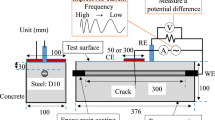Abstract
Electric resistance and emissions of hydrogen and radon isotopes of concrete (which is somewhat similar to fault-zone materials) under increasing uniaxial compression were continuously monitored to check whether they show any pre- and post-failure changes that may correspond to similar changes reported for earthquakes. The results show that all these parameters generally begin to increase when the applied stresses reach 20% to 90% of the corresponding failure stresses, probably due to the occurrence and growth of dilatant microcracks in the specimens. The prefailure changes have different patterns for different specimens, probably because of differences in spatial and temporal distributions of the microcracks. The resistance shows large co-failure increases, and the gas emissions show large post-failure increases. The post-failure increase of radon persists longer and stays at a higher level than that of hydrogen, suggesting a difference in the emission mechanisms for these two kinds of gases. The H2 increase may be mainly due to chemical reaction at the crack surfaces while they are fresh, whereas the Rn increases may be mainly the result of the increased emanation area of such surfaces. The results suggest that monitoring of resistivity and gas emissions may be useful for predicting earthquakes and failures of concrete structures.
Similar content being viewed by others
References
Brace, W. F.,A note on permeability change in geological material due to stress, InExperimental Studies of Rock Friction with Application to Earthquake Prediction (ed. Evernden, J. F.) (U.S. Geological Survey Open-File Report 1977).
Brace, W. F., andOrange, A. S. (1966),Electrical Resistivity Changes in Saturated Rock Due to Stress, Science153, 1525.
Brace, W. F., andOrange, A. S. (1968),Electrical Resistivity Changes in Saturated Rocks during Fracture and Frictional Sliding, J. Geophys. Res.73, 1433–1445.
Giardini, A. A., Subbarayudu, G. V., andMelton, C. E. (1976),The Emission of Occluded Gas from Rocks as a Function of Stress: Its Possible Use as a Tool for Predicting Earthquakes, Geophys. Res. Lett.3, 355–358.
Holub, R. F., andBrady, B. T. (1981),The Effect of Stress on Radon Emanation from Rock, J. Geophys. Res.86, 1776–1784.
Honda, M., Kurita, K., Hamano, Y., andOzima, M. (1982),Experimental Studies of H 2 and Ar Degassing during Rock Fracturing, Earth Planet. Sci. Lett.59, 429–436.
Jiang, F., andLi, G. (1981),Experimental Studies of the Mechanisms of Seismogeochemical Precursors, Geophys. Res. Lett.8, 473–476.
King, C.-Y. (1986),Gas Geochemistry Applied to Earthquake Prediction: An Overview, J. Geophys. Res.91, 12,269–12,281.
Kita, I., Matsuo, S., andWakita, H. (1982),H 2 Generation by reaction between H 2 O and Crushed Rocks: An Experimental Study in H 2 Degassing from the Active Fault Zone, J. Geophys. Res.87, 10,789–10,795.
Luo, G., andShi, X. (1980),Experimental Results of Radon and Thoron Emanation from Rock Specimens under Pressure (in Chinese), Acta Seismol. Sin.2 (2), 198–204.
Mizutani, H., Spetzler, H.,Getting, I., Martin III, R. J., andSoga, N. (1977),The Effect of Outgassing Upon the Closure of Cracks and Strength of Lunar Analogues, Proc. Lunar Sci. Conf., 8th, 1235–1248.
Sugisaki, R., Ido, M., Takeda, H., Isobe, Y., Hayashi, Y., Nakamura, N. H., Satake, H., andMizutani, Y. (1983),Origin of Hydrogen and Carbon Dioxide in Fault Gases and its Relation to Fault Activity, J. Geol.91, 239–258.
Teng, T., andSun, L.-F. (1986),Research on Groundwater Radon as a Fluid Phase Precursor to Earthquakes, J. Geophys. Res.9, 12,305–12,313.
Thomas, D. (1988),Geochemical Precursors to Seismic Activity, Pure Appl. Geophys.126, 241–266.
Varshal, G. M., Sobolev, G. A., Barsukov, V. L., Koltsov, A. V., Kostin, B. I., Kudinova, T. F., Stakheyev, Yu. I., andTretyakova, S. P. (1985),Separation of Volatile Components from Rocks under Mechanical Loading as the Source of Hydrogeochemical Anomalies Preceding Earthquakes, Pure Appl. Geophys.122, 463–477.
Author information
Authors and Affiliations
Rights and permissions
About this article
Cite this article
King, CY., Luo, G. Variations of electric resistance and H2 and Rn emissions of concrete blocks under increasing uniaxial compression. PAGEOPH 134, 45–56 (1990). https://doi.org/10.1007/BF00878079
Received:
Revised:
Accepted:
Issue Date:
DOI: https://doi.org/10.1007/BF00878079




